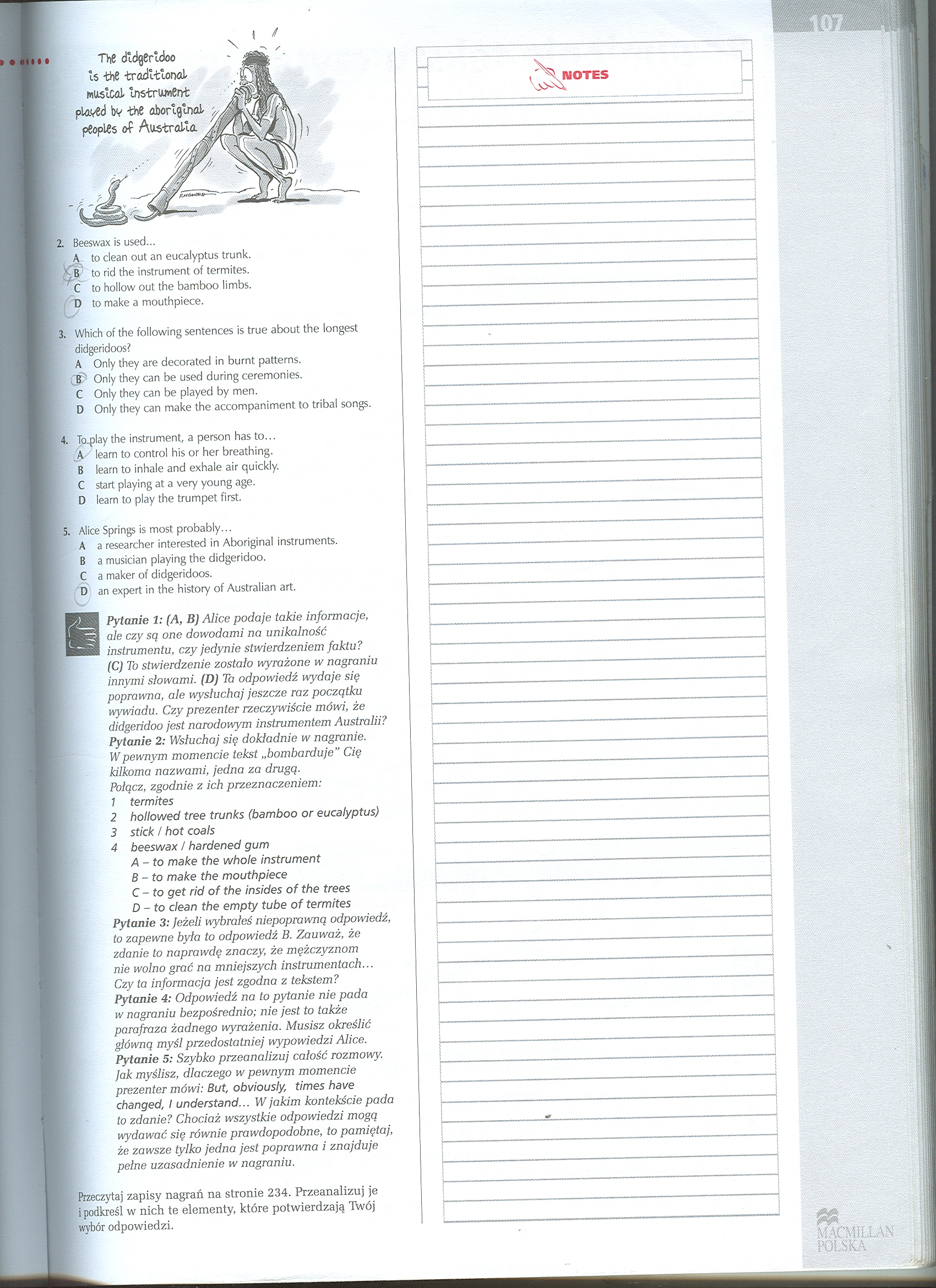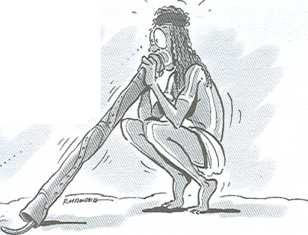skanuj0017 (190)

The didgeridoo Is the -tradltlonal musical Instrument plaved bv the aborlglnal peopies of Australia



NOTES
h
-ii


Beeswax is used...
A to clean out an eucalyptus trunk. B to rid the instrument of termites. C to hollow out the bamboo limbs. D to make a mouthpiece.
3. Which of the following sentences is true about the longest didgeridoos?
A Only they are decorated in burnt patterns.
B Only they can be used during ceremonies.
C Only they can be played by men.

D Only they can make the accompaniment to tribal songs.
4. Touplay the instrument, a person has to...
|: (ty learn to control his or her breathing.
B learn to inhale and exhale air quickly.
C start playing at a very young age.
D learn to play the trumpet first.
5. Alice Springs is most probably...
A a researcher interested in Aboriginal instruments.
B a musician playing the didgeridoo.

C a maker of didgeridoos.
D an expert in the history of Australian art.
| Pytanie 1: (A, B) Alice podaje takie informacje, ale czy sq one dowodami na unikalność I instrumentu, czy jedynie stwierdzeniem faktu?
(C) To stwierdzenie zostało wyrażone w nagraniu innymi słowami. (D) Ta odpowiedź wydaje się poprawna, ale wysłuchaj jeszcze raz początku wywiadu. Czy prezenter rzeczywiście mówi, że didgeridoo jest narodowym instrumentem Australii? Pytanie 2: Wsłuchaj się dokładnie w nagranie.
W pewnym momencie tekst „bombarduje” Cię kilkoma nazwami, jedna za drugą.
Połącz, zgodnie z ich przeznaczeniem:
1 termites
2 hollowed tree trunks (bamboo or eucalyptus)
3 stick / hot coals
4 beeswax / hardened gum
A -to make the whole instrument B - to make the mouthpiece C -to get rid of the insides of the trees D -to clean the empty tubę of termites Pytanie 3: Jeżeli wybrałeś niepoprawną odpowiedź, to zapewne była to odpowiedź B. Zauważ, że zdanie to naprawdę znaczy, że mężczyznom nie wolno grać na mniejszych instrumentach...
Czy ta informacja jest zgodna z tekstem?
Pytanie 4: Odpowiedź na to pytanie nie pada w nagraniu bezpośrednio; nie jest to także parafraza żadnego wyrażenia. Musisz określić główną myśl przedostatniej wypowiedzi Alice. Pytanie 5: Szybko przeanalizuj całość rozmowy. Jak myślisz, dlaczego w pewnym momencie prezenter mówi: But, obviously, times have changed, I understand... W jakim kontekście pada to zdanie? Chociaż wszystkie odpowiedzi mogą wydawać się równie prawdopodobne, to pamiętaj, że zawsze tylko jedna jest poprawna i znajduje pełne uzasadnienie w nagraniu.
Przeczytaj zapisy nagrań na stronie 234. Przeanalizuj je i podkreśl w nich te elementy, które potwierdzają Twój wybór odpowiedzi.
Wyszukiwarka
Podobne podstrony:
skanuj0083(1) Read the text and act it out. Przeczytaj i posłuchaj. Odegraj sztukę. Alien 1: (artifi
skanuj0257 2 shuttles The butterfly is madę continously - commcncc at ring A.DIANA 2 shuttles T
skanuj0267 OLIYIA 2 shuttles The upper part of thc wing is madę in 2 rounds. The rings b - B are tat
skanuj0009 (32) When verb is preceded by another auxiliary verb Sandhi r When the spelling of word e
37 (190) THE PATTERN COLLECTION • 37 Diag. 25KNOW-HOW 9 To renew a bali thread It is not strictly ne
skanuj0001 Probably the most commonly found machinę is the totally-enclosed, fan-cooled motor (TEFC)
f17 6 Letters to the Editors The "Letters to the Editors" section of HeartWeb is intended
FIG 08(1) Figurę 28. The inner mechanism of a magnelic lock is rather simpEe. Figurę 29. The magneli
więcej podobnych podstron